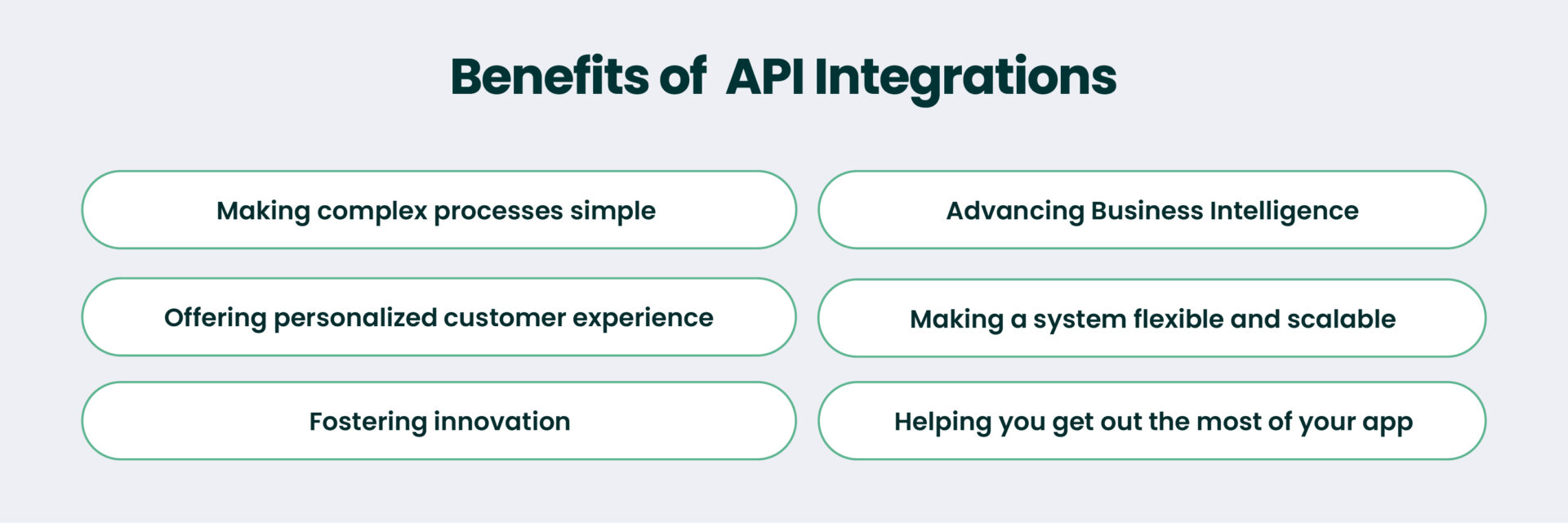As the number of technologies grows, businesses opt for them by integrating them into their activities. As a result, the demand for seamless integration between different software systems is booming. Application Programming Interfaces (APIs) have become a crucial component of modern technology, allowing various systems to interact with each other. Why has this solution become so popular?
First, companies opt for API integrations because they are 30% more likely to achieve digital transformation success. Second, businesses shifting towards software integrations experience a 24% increase in operational efficiency.
Jumping between multiple apps to get work done and copy-paste information between systems is no longer a dilemma. API integrations automate tasks, saving time and boosting efficiency. For example, API can connect your POS solution with external tools, allowing for real-time updates and data synchronization.
However, many businesses still don’t fully understand how API integration can assist them and affect their operations. That’s why, in this article, we want to explain everything you need to know about API integration services. From defining APIs to outlining the benefits for your company, we’ll share how to navigate and enable the interaction between various systems effortlessly.
What Is an API Integration?
An API is a bridge between different software applications that ensures they work and communicate with each other, regardless of their programming languages. An API is a set of rules and protocols that apps use to request and exchange data. The core capacity of API integration is that it enables systems to work seamlessly. As a result, businesses can use the functionalities of various apps without completely replacing existing software.
Different types of APIs serve many purposes and have various applications. Here are some of the most common types of web APIs:
- Open APIs for creating novel apps based on organizational features or service data
- Partner APIs for designing unique features by using a partner’s resources
- Internal APIs for internal use and transmission of data between different components of a system
- Composite APIs for combining multiple APIs into one interface
API protocols are strict guidelines used to integrate two parties using an API and regulate interactions. The value of API protocols is that they enhance efficiency when exchanging data within various apps. Here are the different types of API protocols:
- REST APIs create dependable, user-friendly API systems that work seamlessly across platforms and devices.
- SOAP APIs ensure communication between two apps over a network and strengthen security.
- GraphQL APIs enable building a fast API solution and speed up the development process.
- Webhook APIs facilitate real-time transmission of data and seamless integration between different web apps.
- RPC APIs enable apps to execute remote functions seamlessly over long distances.
API integration connects two or more apps via their APIs, allowing them to exchange data. API integrations play a vital role in business by powering their processes and making them high-performing. As a result, companies can boost their productivity, keep data in sync, and drive revenue.
So, different APIs and API protocols have different purposes and serve specific business needs.
Contact us to discover which API fits the best your company’s needs and how it can streamline your workflows and optimize your business processes.
How does API Integration Work?
The process of API integration involves establishing a connection between multiple software applications. API endpoints enable this connection and serve as gateways for data transmission. They also define the specific data formats and methods that the API supports.
The advantage of this approach is that when two software applications integrate via API, they can exchange information in real-time. For example, your online store might integrate with a payment gateway using an API. When a customer makes a purchase, the e-commerce website sends a request to the payment gateway’s API. The API then processes the payment and responds, indicating the transaction status.
API integrations can take different forms depending on the purpose and complexity of the integration. From data retrieval to synchronizing data between multiple software apps in real-time, e-commerce integration ensures both simple and complex interactions between your systems.
Benefits of API Integrations When Connecting Systems Together
According to the latest report, the global API management market is projected to reach $47 billion by 2030 with an annual growth rate of 31,1% over the forecast period (2022-2030). The success factor here is the companies’ investments in IT setup.
But what makes API integration a powerful tool for businesses? Let’s review the benefits of integrating and connecting diverse software applications.
Making complex processes simple
With API integration, it is possible to simplify complex processes. By integrating different systems, companies reduce manual labor and automate workflows. As a result, this is a great way to save time and eliminate the probability of human errors.
For example, companies can use API integration to boost customer service processes and sales operations. See how it works: a customer places an order, and the sales software automatically sends data to the inventory system and customer service software. As a result, API integration enables updating stock levels and showing the customer’s order history.
Advancing Business Intelligence
API integration brings together data from different sources, greatly enhancing Business Intelligence. This helps companies have a clear picture of their operations, customer behavior, and market trends, leading to more informed decisions.
For example, an API can collect data from social media platforms, CR systems, and website analytics, bringing them all in one place. This unified data view helps businesses identify patterns and insights that can’t be seen in separate data sets.
Offering personalized customer experience
API integration transforms the customer experience by assisting in better responding to rising clients’ expectations. As a result, businesses can provide seamless and personalized customer services across multiple touchpoints.
For instance, a retail company can use APIs to integrate its e-commerce platform with the system it uses for its brick-and-mortar store. Moreover, businesses can also use APIs to check real-time inventory data and understand whether a product is available for their clients. So then, they will inform their customers whether they can buy this product online or at a physical store.
Making a system scalable and flexible
API integration allows businesses to scale up their systems and easily add new features. This flexibility is important in a fast-changing market, helping companies quickly adapt to new tech trends and increasing customer demands.
For example, e-commerce businesses can use API to add a new payment gateway, providing customers with more payment options and enhancing their shopping experience.
Fostering innovation
Another benefit of API integration is that it drives innovation by facilitating data and functionalities exchange. Developers can also use APIs to create new services and apps without the need to deal with the complexities of a system.
For instance, a logistics platform could use APIs to integrate data from different freight carriers, warehouse operators, and inventory management systems. This integration would allow the platform to offer a comprehensive logistics management service, enabling customers to book and track shipments, manage inventory, and coordinate warehousing and distribution services seamlessly.
Helping you get the most out of your apps
With API integration, you’ll get the most out of your app. First, your CRM platform will reflect a complete view of clients, helping sales representatives manage relationships with the target audience. Second, your applicant tracking system can aid in the recruitment of candidates. Third, your ERP system can display accurate order information and generate invoices instantly, helping your finance team.
Contact our team today to unlock more benefits for your business with our advanced API integration solutions.
API Integration Use Cases By Industry
APIs can be used for different purposes, depending on the industry and business’s unique needs. Here are some common use cases by industry.
API integrations in logistics
In logistics, APIs are used to provide real-time tracking and share data between different systems. As a result, customers have access to real-time updates on the status and location of their shipments while businesses optimize their supply chain operations.
APIs also contribute to better delivery management. They are used to integrate delivery management systems with other logistics software. This allows companies to manage warehouse operations, track inventory, and optimize delivery routes more efficiently.
Finally, APIs are used to create freight platforms where shippers and carriers can interact and arrange for transportation. As a result, shippers can find carriers more easily.
API integrations in manufacturing
APIs connect warehouse management software with manufacturing systems and ERPs. This allows manufacturers to optimize and monitor inventory levels and streamline picking and shipping processes.
If you’re an e-commerce business, you might be interested in integrating your online store with warehouse management software and manufacturing systems. The advantage of e-commerce integration for your company is that it enables placing orders in cases when there is sufficient inventory.
Finally, marketplace integration will be interesting for businesses that want to connect their platforms with manufacturers’ ERPs to manage orders, inventory, and fulfillment. The value of marketplace integration is that it provides greater customization to meet changing marketplace requirements.
API integrations in retailing
Retailers can use API integration for data-driven decision-making. APIs help retail companies gather customer data, enabling targeted marketing campaigns and better customer experiences. They also connect retailers with partners and third-party providers for product and inventory data, enhancing the overall customer experience. Finally, integrating various systems allows retailers to offer better customer service, stand out from the competition, and build long-lasting relationships.
So, with tons of data being generated daily, businesses in the retail industry are turning to API integration to help them make sense of it all and lead them to more informed decisions. By using APIs, retailers improve their productivity and efficiency, automate processes, and reduce costs. As a result, they’re interested in integrating different systems.
How to Build API Integration
Once you decide to integrate your apps via their APIs, you can opt for the following options:
- Native API integration: Using an app’s pre-built integration with another app. This is a good choice because you’ll save costs and receive reliable support from an app provider.
- In-house API integration: Building the integration from scratch. This option will allow you to customize your API to your organizational needs.
- Third-party integration: Using a middleware platform for integration. This variant allows for integrating multiple apps quickly and securely and provides support for existing and new software.
So, when you are looking to implement it, you have to understand your needs to pick up API integration that meets your business requirements.
At Forbytes, we offer system integration services to connect your third-party systems, internal systems, and business tools into a unified digital environment. This enables automated data transfer and smooth communication between them.
Contact us today to transform your systems into a cohesive, efficient whole. Overcome compatibility barriers and ensure data security with our expert integration services.













